Ficus carica
The occasional pejorative use of the term “fig leaf” is wholly undeserved.
The leaves of the fig tree (Ficus carica) are quite lovely – large, beautifully shaped, and generous in their provision of shade.
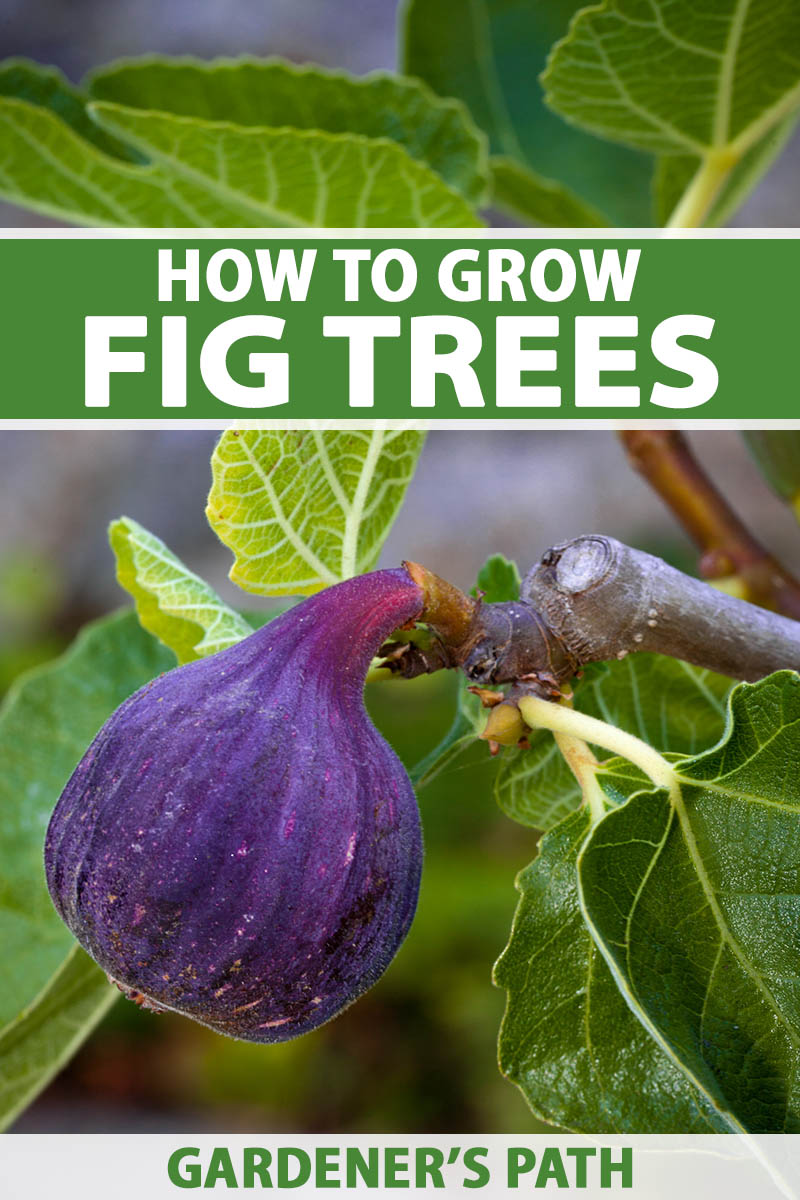
We link to vendors to help you find relevant products. If you buy from one of our links, we may earn a commission.
It is entirely unjust that the leaves of this lovely tree have been so maligned throughout history, likely due to their part in the biblical story of Adam and Eve.
Any plant that gives us food, beauty, and shelter surely deserves our respect and admiration, rather than our scorn.
In fact, who could think anything other than thoughts of praise and worship when they bite into a fig?
They’re practically perfect, with syrupy sweetness balanced by a melon- or berry-like brightness. Not even a caramel apple can compare.
Mouth watering? Don’t worry, you’ll be plucking your own fruit warm off the tree in no time. Here’s what we’re going to discuss in order to make that happen:
What You’ll Learn
Do you already have a list of treats you can’t wait to make with your soon-to-be fig bonanza? Then let’s jump in.
Cultivation and History
Native to the Middle East and northwestern Asia, figs are one of the earliest known cultivated fruit trees. There’s evidence that they were cultivated in Mesopotamia 12,000 years ago.
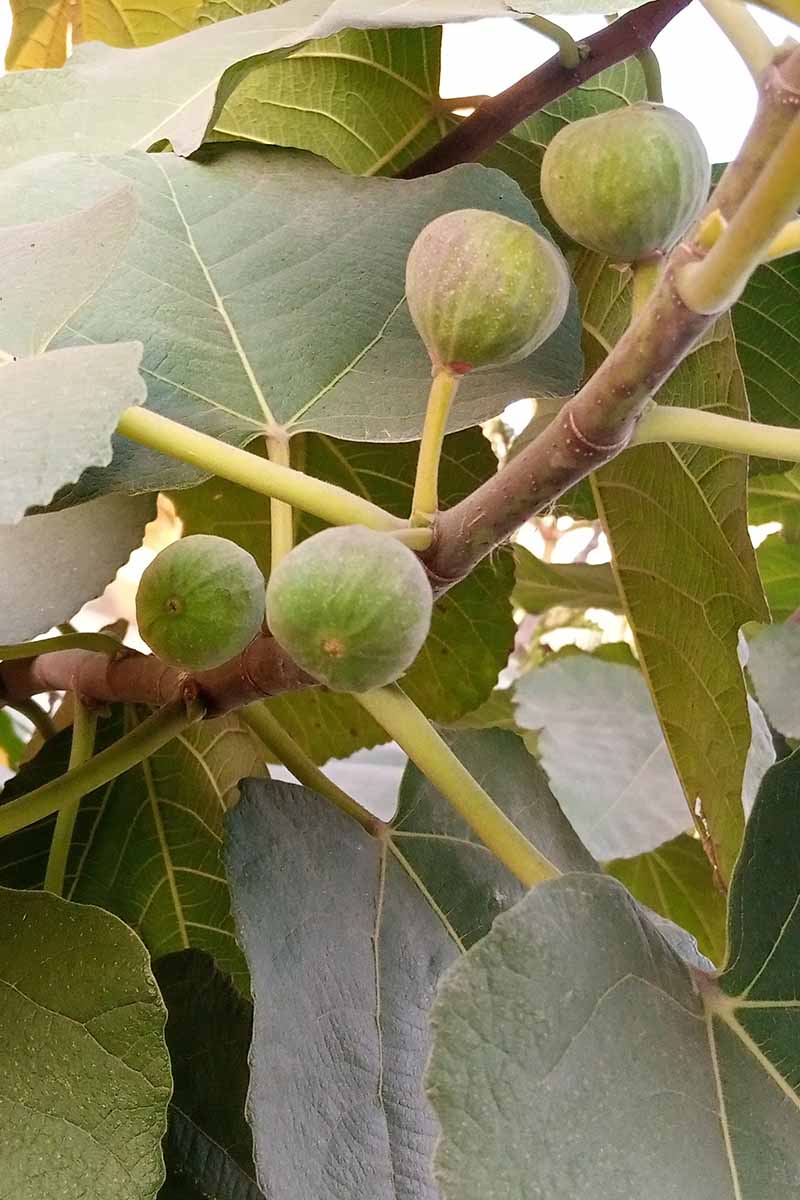
Ancient Greeks, Egyptians, and Romans grew them for food, wine, and medicine, and the tree was brought to North America by Spanish missionaries in the early sixteenth century.
Turkey, Egypt, and Spain are the largest commercial producers today.
Easy-to-grow figs are members of the Moraceae family, which also includes mulberries.
These trees can be left unprotected in USDA Hardiness Zones 8 to 10. Gardeners in northern Zones can grow these plants in containers and bring them indoors when temperatures drop below 10°F.
Determined growers can even find cold-hardy figs that can survive down to Zone 6 with some protection.
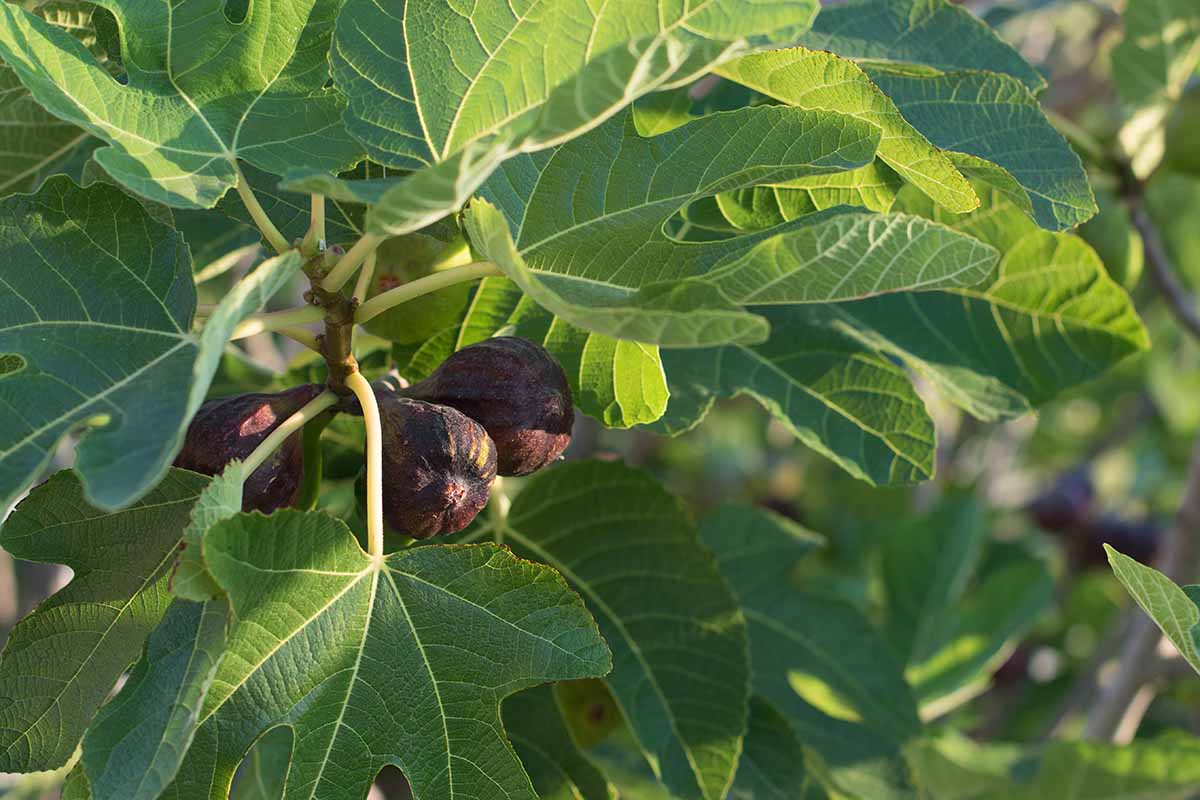
These trees are relatively fast growing – most grow to 20 or even 30 feet tall, and almost as wide. Some can even grow 70 feet tall!
The deeply-lobed leaves can be four to eight inches wide and as long as 10 inches.
The shade provided by their girth and large leaves is well-appreciated. In fact, the founder of Buddhism, Siddhartha Gautama, is said to have found enlightenment while sitting under a fig tree.
In the right conditions, some species will produce two crops in a year. The first, called a “breba” crop, ripens in late May or early June, and a second harvest will be ready in late September to early November.
These different crops appear on completely different buds: the apical bud and the lateral bud.
Breba buds develop on last year’s growth while the second crop develops on older wood. The lateral buds are below the apical or breba buds.
“Breba” or “breva” is a Spanish word that comes from the Latin “bifera,” which means twice-producing, according to Linda Ziedrich, author of “Jams, Jellies, and Other Sweet Preserves.” Want to check it out for yourself?

Jams, Jellies, and Other Sweet Preserves
This book is available on Amazon.
The fruits can be green to nearly black, and the flesh can range from white to nearly black, as well. They can also be pear-shaped, round, or oval.
The first time you encountered a fig, if you can remember it, you might have marveled at how unusual it is. The fruits don’t have a center pit like a stone fruit, nor are they filled with seeds like a pomegranate.
That’s because the fruits are actually inverted flowers. In botanical terms, this is known as a syconium. Those sort of fuzzy bits surrounding the hollow interior of the syconium are the female and male flowers.
But since we all know them as fruits, that’s what we’ll call them in this guide.
Fig Tree Propagation
It’s possible to grow figs from seed, but it’s a long, difficult, drawn-out process with unreliable results. Best leave it to the experts.
If you want to recreate a plant you love, cloning cuttings is an easy and reliable way to do it. Otherwise, you can find figs for sale at nurseries in containers.
Let’s talk about cuttings first.
From Cuttings
This species is astonishingly easy to propagate. Simply sneak into your neighbor’s yard in the dead of night, pruners in hand…
We jest. Ask permission and take an eight- to 10-inch cutting of young growth in the early spring. Cut the bottom end at a 45-degree angle, and dip it in rooting hormone if you wish.
Rooting hormone helps speed up the process, but it’s not absolutely necessary with figs. They are pretty good at growing from cuttings all on their own.
Still, it never hurts to try and push the process along.
Especially if you also hope to propagate other types of plants, now or in the future, Bonide II Rooting Hormone is available at Arbico Organics in 1.25-gram containers if you don’t already have some.
Bonide Bontone II Rooting Powder
Stick the cutting in a six-inch pot filled with potting soil, with a third of the cutting set below the surface and one or two leaf buds above the soil line.
Let the cutting grow in the container for a season outdoors in a spot with at least six hours of sunlight per day.
Be sure to keep the soil moist but not wet. If you live in Zones 6 or 7, bring the plant indoors during the winter and keep it in a sunny window or under grow light.
The following spring, transplant it.
My own huge tree is the result of my dear neighbor Louie sharing a potted plant he’d propagated from a cutting that he snipped from a tree at the side of a road somewhere.
When he lost his own tree during the construction of his backyard pool, he came back to our big beauty to take a cutting to propagate.
From Seedlings/Transplanting
Plant figs when they are dormant in early spring. Spacing will depend entirely on the specific variety that you’re growing. Some only need five or six feet, while larger trees will need 10 or more feet.
Dig a hole twice as wide and twice as deep as the nursery container. If your soil is extremely heavy or sandy, work lots of well-rotted compost into the removed soil.
Set container plants three inches deeper than their container depth and fill in around the rest of the root ball with the removed soil.
Water well and add more soil if the soil settles at all.
If you’re planting bare root plants, soak the roots for a few hours before planting. Plant as described above, but cut back the tops to about half of their original length.
How to Grow Fig Trees
Like college kids on spring break, figs like sun.
They are happiest with seven to eight hours of full sun during the growing season. The more sun they receive, the more productive your tree will be.
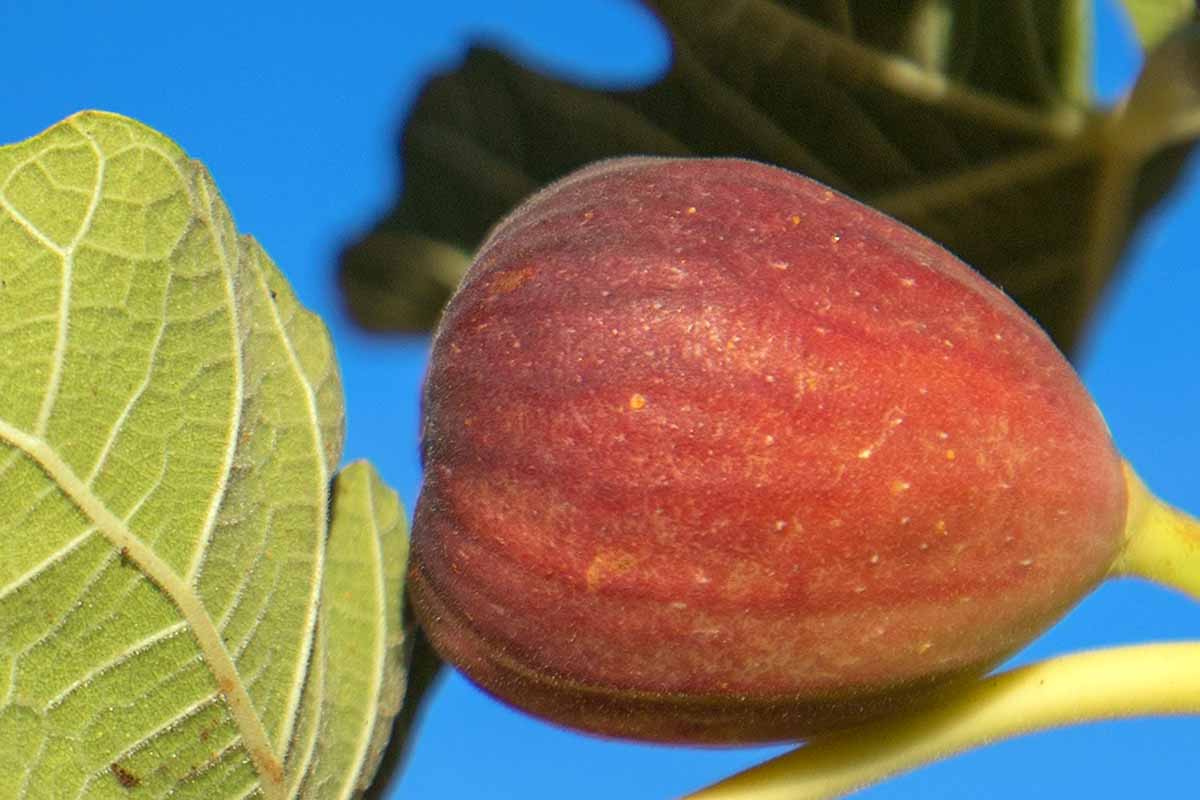
I have a tree in full (yes, full) shade that produces about 50 figs for me each year.
But I have another of the same age and type that produces much, much, much more. Location is everything.
When choosing a site for your tree, don’t underestimate its ability and desire to spread out. It might feel a bit crowded if it’s too close to a wall or fence. Check the ultimate size at maturity and give yourself a few extra feet beyond that.

These trees aren’t too picky about their soil, although they prefer well-drained loam with lots of organic matter. The soil pH should be anywhere from 6.0 to 7.5.
These plants are drought tolerant, but just because they can tolerate dry conditions, that doesn’t mean they aren’t causing issues.
Think of water as the green light to grow. When there’s a lack of water, the stop light comes on and the tree stops growing. Your tree might even drop fruit.
Typically, a fig won’t die because of drought. It will just stop growing and fruiting until conditions improve. That’s not exactly what we want, right?
However, too much water can cause root rot. And it reduces the concentration of sugar in the fruits, which you don’t want either.
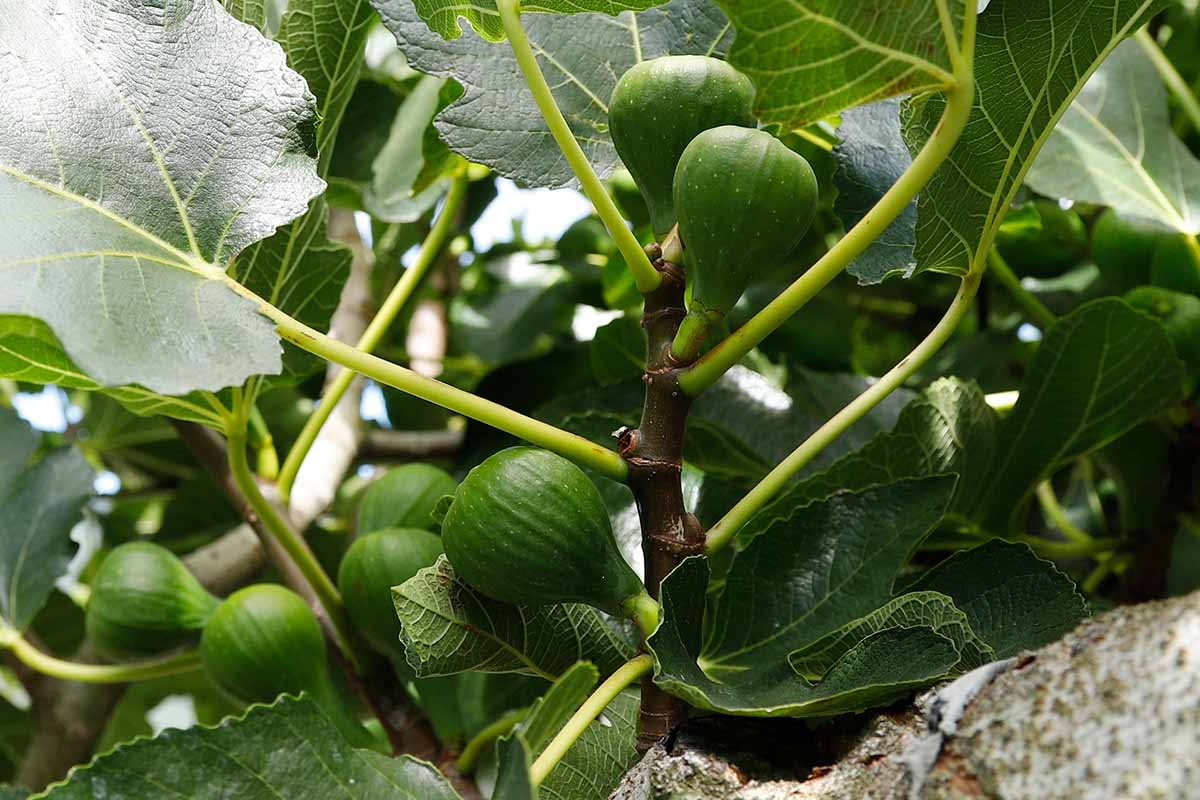
The best strategy is to water well before fruit formation and taper off slightly after that.
Before fruit-set, the soil should stay consistently moist but not soggy. After fruit-set, only water when the top four inches of soil dry out.
Then, if you get frost in your area, don’t water at all in the two months prior to frost. This helps strengthen the branches in preparation for winter, a process known as lignification.

To improve budding and fruit set, place black mulch around the base of your tree, but not touching it. This will help increase the temperature of the soil. Figs develop best when the soil is around 78°F.
These trees generally do just fine without any fertilizing.
If it seems your tree is being stingy with its spring leaf development, give it some balanced fertilizer such as 10-10-10 (NPK), according to package instructions, to jumpstart it.
Don’t fertilize after fruit-set.
You should also fertilize if your annual soil test (you’re doing an annual soil test, right?) shows any deficiencies.
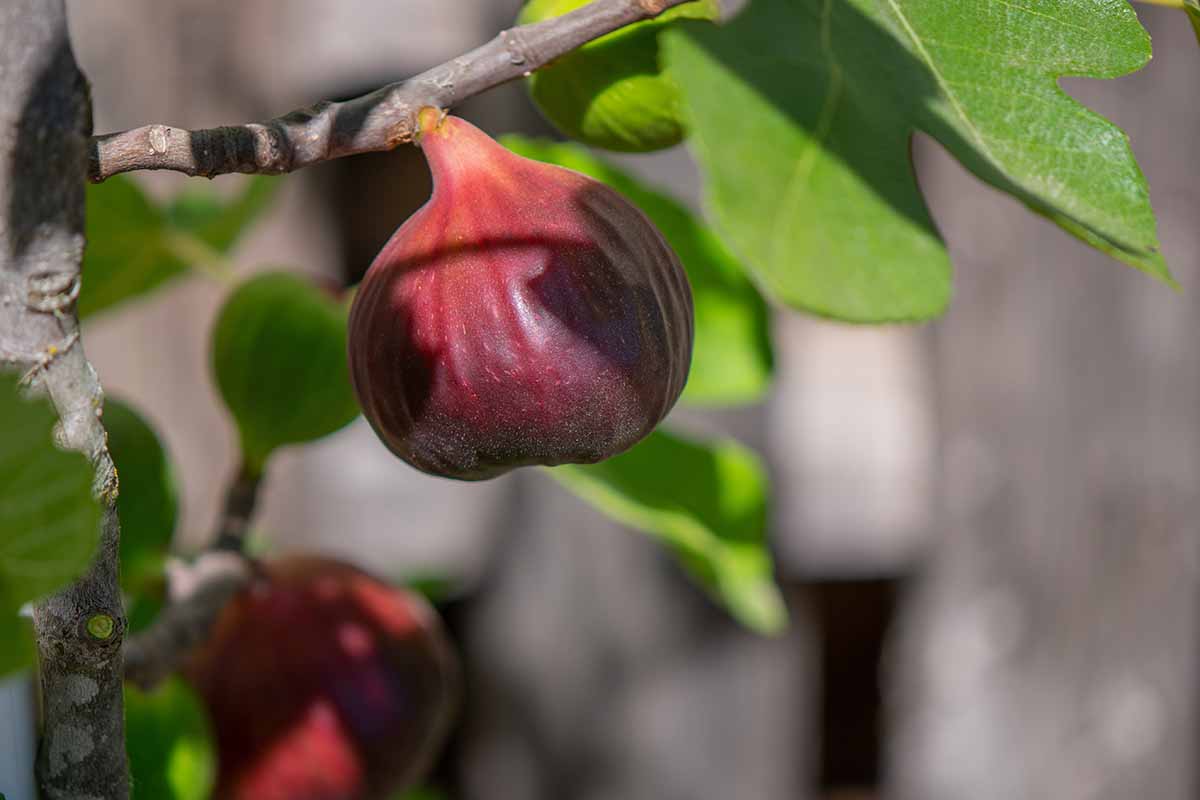
Figs are a little unusual in how they are pollinated. Fig wasps (Blastophaga psenes) evolved alongside figs in a symbiotic relationship. But that means you can’t rely on bees and butterflies to do the work.
The good news is that most figs that we grow in the garden don’t need pollination at all to produce fruit. But if they are pollinated, you’ll get larger, sweeter fruits.
It’s too much work to pollinate every fruit, but if you want to pollinate a few to taste the difference or for a special meal, go ahead and hand pollinate – this is called caprification.
Label those figs with a piece of string or something similar, and cover them with mesh as they near ripeness so herbivores don’t get to enjoy all your hard work.
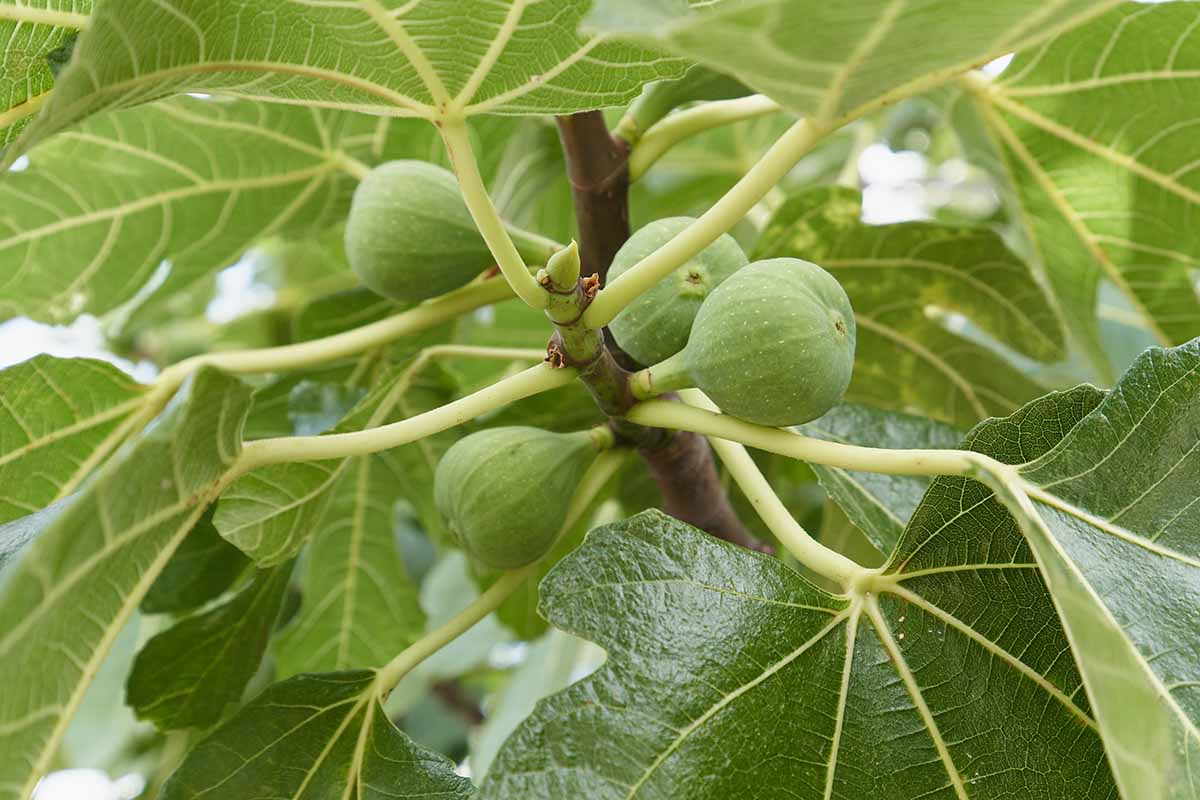
I know it may seem like unnecessary labor, but once you taste a caprified fig, you will never want anything else.
To hand pollinate, grab a ripe fruit and cut it in half or into quarters. This fruit should be from the breba crop.
You probably can’t see the pollen, but it’s there. Turn a slice over a piece of black or white paper and knock the back of the fig. The pollen will fall on the paper.
Mix all of the pollen from one fruit with a solution of 2 percent sucrose and 100 milliliters of distilled water. Put this in a syringe.
Take a developing fig on the tree and inject this solution into the center of the base of the fruit until the fig is filled and the liquid starts to squirt back out the base. It doesn’t take much solution.
You should make sure to mark the pollinated fruit, but it will also stand out if you don’t pollinate its friends because it will usually mature earlier.
Growing Tips
- Grow in full sun, or expect a reduced harvest in partial sun.
- Trees are drought tolerant but perform better with regular moisture.
- Fertilize only if a soil test shows it’s necessary.
Pruning and Maintenance
These trees aren’t like stone fruits, which need regular pruning to refresh and optimize production. In fact, figs require little or no pruning.
An ill-placed branch can certainly be removed to unblock a path if needed, of course. Do so in the winter.
And you’ll want to remove any deadwood any time you see it.
We call this removing the three Ds: damaged, deformed, or dead growth. Wait until winter, unless a branch just needs to go right away because it’s broken or diseased.
Then, take a clean pair of clippers or a saw and cut the branch.
You should also prune every few years to maximize light exposure and improve air circulation. Do this when the tree is dormant in the winter as well.
Fig Tree Cultivars to Select
Of the four main types of figs, three – Caprifigs, Smyrna, and San Pedro – are not usually grown by home gardeners, because they have complex pollination requirements.
Remember how we talked about fig wasps? These need the help of fig wasps or hand pollinating to produce a harvest.
Fig wasps pretty much only live in large numbers in areas where wild figs grow. In the US, that’s mostly just in California.
The fourth type, the common fig, is parthenocarpic, meaning the fruit forms without fertilization. Let’s look at a few varieties of this type.
Black Mission
Super-southern gardeners might want to try ‘Black Mission’ – it’s a vigorous grower, but not particularly cold hardy.
This variety produces two crops of large, rich-tasting, purple-black fruits that are tasty fresh or dried. You’ll get a lot of them, too, because this tree grows up to 35 feet tall.
Nature Hills Nursery sells this tree in #5 containers.
Brown Turkey
‘Brown Turkey’ is another favorite, especially for more northern gardeners.
It’s more cold-hardy than some other varieties, thriving in Zones 7 to 9, and it grows to about 30 feet up in ideal conditions.
This tree produces smaller fruit that is not quite as richly flavored as ‘Celeste,’ which we’ll cover next, but it does often produce a breba crop. And that means figs to pick for more of the year!
You can find ‘Brown Turkey’ available at Nature Hills Nursery.
Celeste
One of the most commonly planted fig trees in North America is ‘Celestial’ or Celeste.
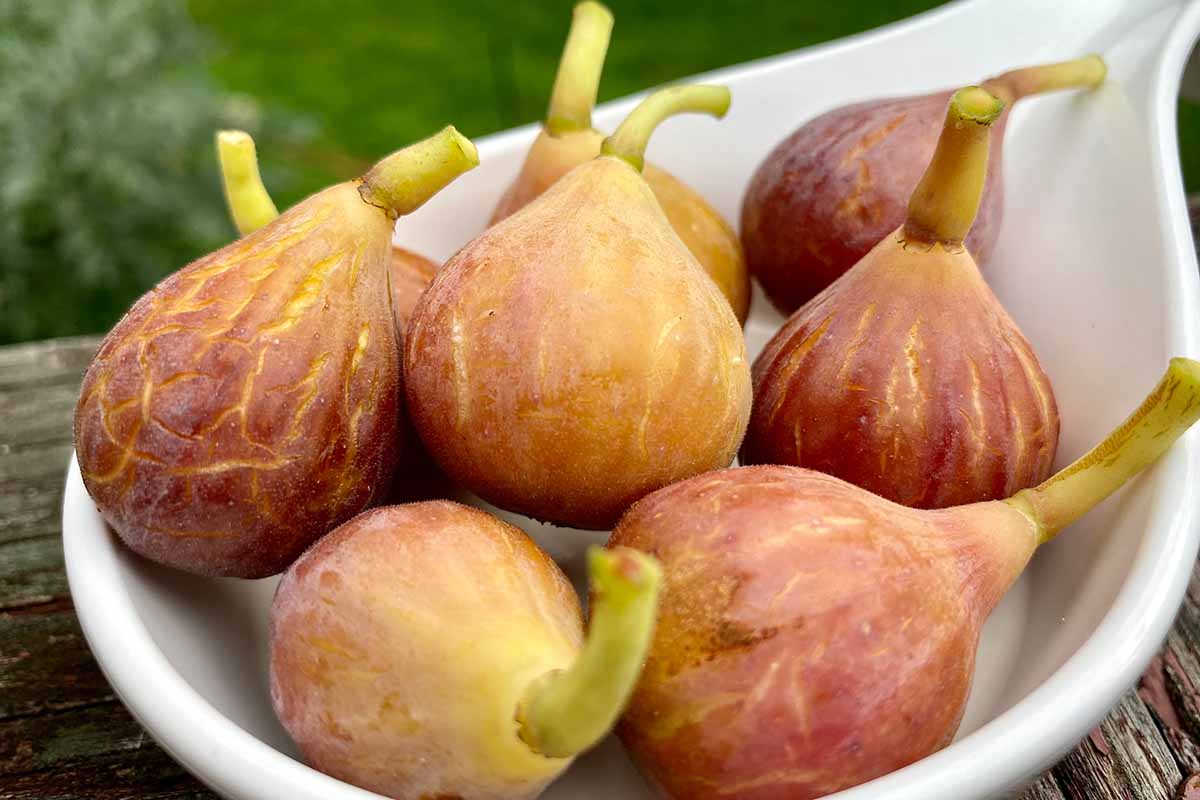
This large beauty is fast-growing and produces medium-sized, sweet, juicy fruits that are brownish-purple and ready to harvest in July. It’s also pest and disease resistant.
Celeste does not produce a breba crop, but the summer fruit is marvelous, both for eating fresh and for preserving.
Also known as the sugar fig, it’s hardy to Zone 6. It’s petite, usually staying around 10 feet tall.
You can find Celeste available from Nature Hills Nursery.
Desert King
‘Desert King’ should probably be named Winter King. This tree has been known to survive the winter as far north as Zone 5, though that’s tempting Mother Nature.
Planting in Zone 6 and up is safest.
The yellow-green fruits and pink pulp are sweet and strawberry-like. ‘Desert King’ grows to a respectable 15 feet tall, which is not too tall or too small for most home growers’ needs.
If you live in a cooler climate, grab one for your garden at Fast Growing Trees.
Hardy Chicago
‘Hardy Chicago,’ aka ‘Bensonhurst Purple,’ is another cold-hardy cultivar that thrives in Zones 5 to 11. It will require some winter care at the more northern range of its tolerance.
Growing to a mature height of 10 to 15 feet tall and a spread of nine to 12 feet, ‘Hardy Chicago’ produces brownish-purple fruits that look similar to those of ‘Brown Turkey.’
You can find trees available at Nature Hills Nursery.
And read our guide to growing ‘Hardy Chicago’ for more information.
Little Miss Figgy
I mean, with a name like that, who could possibly resist?
Little Miss Figgy™ is freakin’ adorable and ideal for anyone who needs a tree they can move around.
Bring it indoors in colder regions as needed or move it around your patio to chase the sun. It can stay outdoors in Zones 7 to 10.
It won’t grow much larger than five feet, and while you won’t be harvesting bushels of fruit, it will certainly give you enough to keep your family in fruit with both a breba and a secondary crop.
The dark purple figs are fabulously sweet. If you’ve ever had ‘Violette de Bordeaux’ fruit, then you know how tasty this variety is because it was bred from that marvelous tree.
Pick one up at Fast Growing Trees.
Managing Pests and Disease
While there are a few diseases and insect pests that can be a challenge to manage, your biggest foes will usually be herbivores. Let’s get the bad news out of the way first.
Herbivores
You didn’t think herbivores like birds and squirrels would ignore these sweet, delectable treats, did you?
Let’s talk about the critters that are eyeballing your treats:
Birds
Birds will snag a bud or immature fruit and I’ve seen them nibbling on mature fruits, too. But generally, there are enough fruits to share and I don’t do anything to deter birds.
I find putting a feeder full of their favorite foods nearby will keep them entertained and full.
Now, squirrels, on the other hand…
Squirrels
Squirrels. Grrrrrrrr. They act all cute and sweet, with their big fluffy tails and their cute little hands.
But believe me when I tell you that these little jerks are going to be a lot less adorable come harvest time.
I have trees full of nuts, apples, pears, and plums, along with strawberries, salmonberries, raspberries, elderberries, bunchberries, thimbleberries, and gooseberries growing in my garden.
The one thing squirrels will go for above everything else? Figs.
The little thieves will literally climb down an overladen plum tree, wade through my bunchberries, jump over a cane berry, and dodge territorial chickens to reach my fig trees.
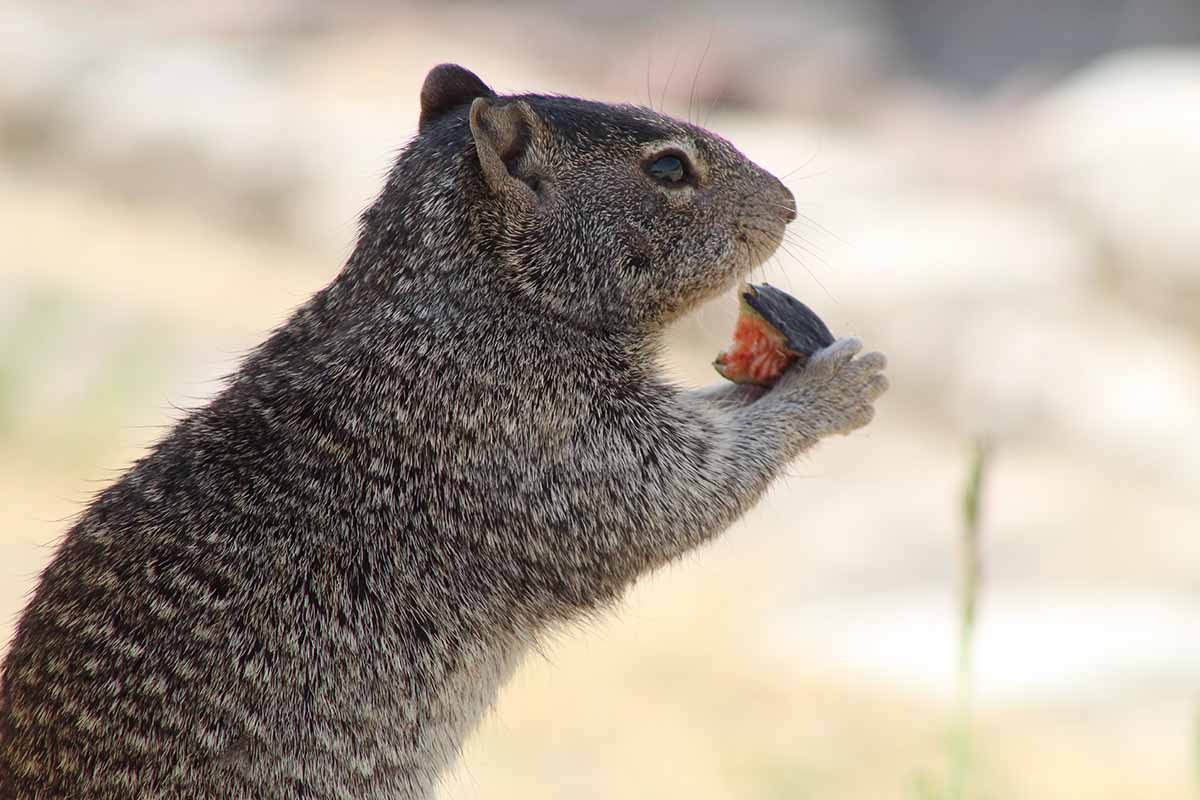
And it’s not just the mature fruits. They eat the immature fruit and the buds, too.
Decoys, motion sensors, and other deterrents don’t work for me. If your tree is isolated from nearby trees, shrubs, or structures, you can use a baffle.
The only thing that consistently works for me is to wrap the fruits in mesh bags. I’m not going to sugarcoat it, it’s a pain in the butt.
But if the options are no figs or a day of tying on bags, I’m going to choose the second one.

I use something like these four-by-six-inch bags from Boshen, which you can buy in packs of 100 or 200 at Amazon.
Tie them on as soon as the fruits are about the size of a grape, unless you notice squirrels making a big dent in your tree buds before then.
Insects
Take a breath because insect pests are probably going to be less of a problem than squirrels. Really, the biggest risk is that they’ll spread unwelcome diseases.
You should also watch for aphids, but here are two of the most problematic creepy-crawlies you may encounter:
Fig Scale
If you’ve ever dealt with scale insects on your houseplants or plants in the garden, this is the same thing, just on a larger, um… scale.
Fig scale (Lepidosaphes conchiformis) are medium or dark brown scale insects with a greasy, waxy coating. Fig wax scale (Ceroplastes rusci) are brownish-pink and have a domed shape that resembles an oyster shell.

They can be found feeding on leaves, twigs, and fruit of the tree, sucking out the sap.
They tend to cluster in groups and they don’t move quickly, so they’re often mistaken for a disease or strange growth rather than a pest.
Make no mistake, they’re eating your tree, causing stippling and stunted growth on young trees.
Don’t use pesticides on this insect. They’re generally ineffective and they can hurt beneficial insects. If you have a severe scale infestation, it’s likely because there’s an imbalance in your garden already.
You can scrape them off of young trees with a butter knife, and use a dormant oil during the winter to kill off overwintering pests.
Mature trees won’t usually need treatment, but it never hurts to beef up your beneficial predator populations.
Lacewings love scale. Bring home some eggs from Arbico Organics in quantities ranging from 1,000 to 250,000.
Root-Knot Nematodes
Root-knot nematodes (Meloidogyne spp.) are a serious threat to fig trees in parts of the southern US.
The larvae of these destructive pests infect plant roots, inhibiting their ability to absorb nutrients.
According to G. W. Krewer, extension horticulturist, and Floyd Hendrix, plant pathologist, both of University of Georgia Extension Service, trees infested with root-knot nematodes cannot be cured with chemical treatment.
Krewer and Hendrix suggest pruning the tops to balance the weakened root system, which may prolong the tree’s life. Usually, however, infested plants eventually succumb and die.
Disease
Diseases can be a serious threat to your trees. Your best chance at keeping your trees healthy is to spot these problems early on and do what it takes to get rid of them before they become a serious issue.
Gardeners can avoid most of these by using sanitary gardening practices such as applying mulch, cleaning away dead plant material, and disinfecting tools.
Figs are susceptible to a couple of different fungal blights, including botrytis limb and pink blight, so let’s talk about blight first.
Botrytis Blight
Caused by the fungus Botrytis cinerea, Botrytis blight results in cankers that girdle twigs and limbs and cause them to die back.
This disease usually impacts just a few branches here and there and it’s not the entire tree that will be affected.
Botrytis loves cool, wet weather, so spring is when it really sparkles.
Prevention is the best medicine, so spray your trees with copper fungicide in the spring as the leaves emerge and repeat every three weeks until the warmer, drier weather arrives.
Copper fungicide works against all kinds of fungal diseases, which makes it worth keeping around.
Pick up a pound or four pounds of dust, which can be mixed with water to use as a spray, at Arbico Organics.
If Botrytis is already present, prune away any symptomatic limbs and treat with copper. Clean up your garden in the fall and dispose of any symptomatic fruit in the garbage, not in your compost.
Fruit will be covered in a gray mold when infected. If you’ve ever purchased a carton of strawberries and one or two are moldy, that’s the same pathogen.
Fig Mosaic
Fig mosaic is caused by a virus which is spread on infected garden tools and by pests.
When the virus infects a tree, it causes the leaves to develop yellow and light green lesions and patches. These patches will eventually develop a reddish band around the edges.
Fruit may also become discolored.
While ‘Kadota’ and ‘Calimyrna’ are nearly immune, most other figs are susceptible, with ‘Black Mission’ being particularly prone.
Unfortunately, there’s nothing you can do if the disease is present. Just support your tree to keep it healthy otherwise.
Rust
Rust is another type of blight to be aware of. It’s a fungus that shows up on the underside of leaves as raised, reddish-brown spots.
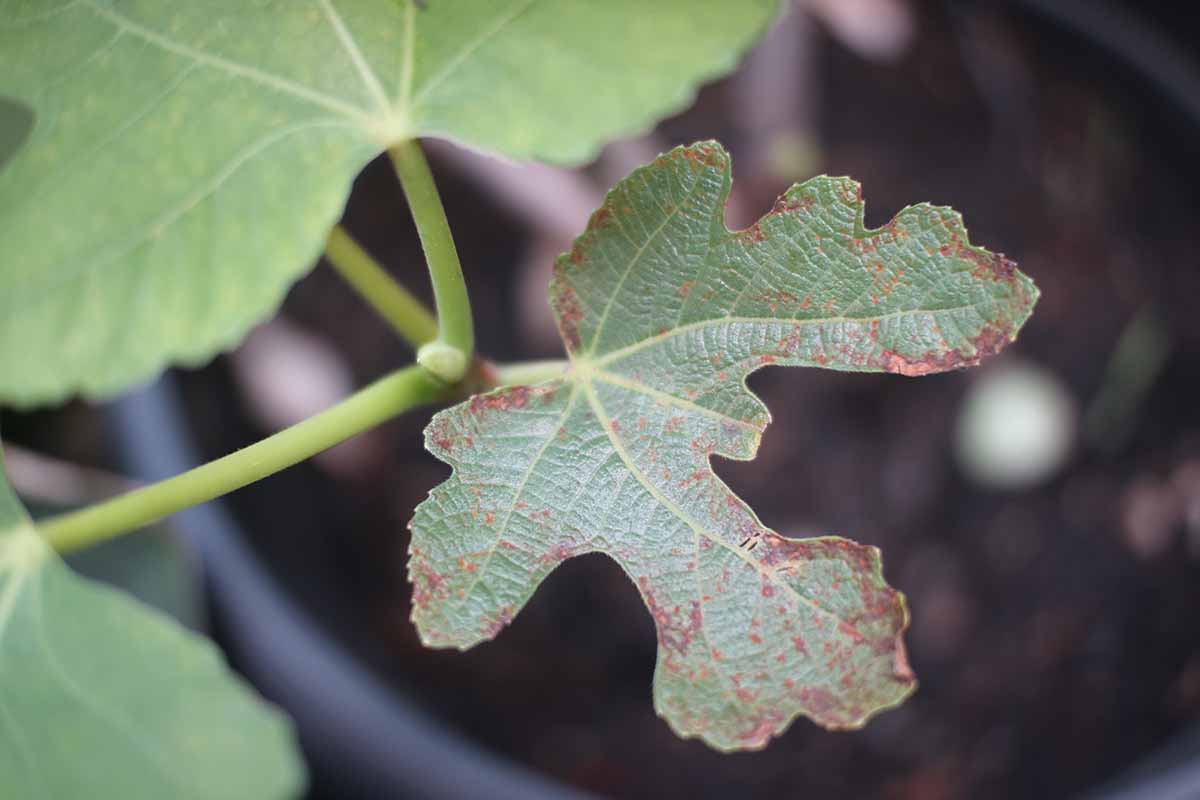
Rust is not usually fatal, and unless it’s an annual problem, spraying with a fungicide is not necessary. Prune off any heavily infested leaves or branches and dispose of the material.
If the disease keeps returning year after year, spray with a copper fungicide early in the spring and again every other week for a total of four treatments.
Harvesting Fig Fruit
It can be a little challenging to figure out if figs are ripe if you’re new to growing them. That’s because they go through growth spurts over a period of 90 days.
When they’re young, they plump up to about half their eventual size and then stay that way for about 30 days.
They swell a bit larger over a few days and then stop growing for another 30 days. Then, they burst to their mature size and stay that way for 30 days.
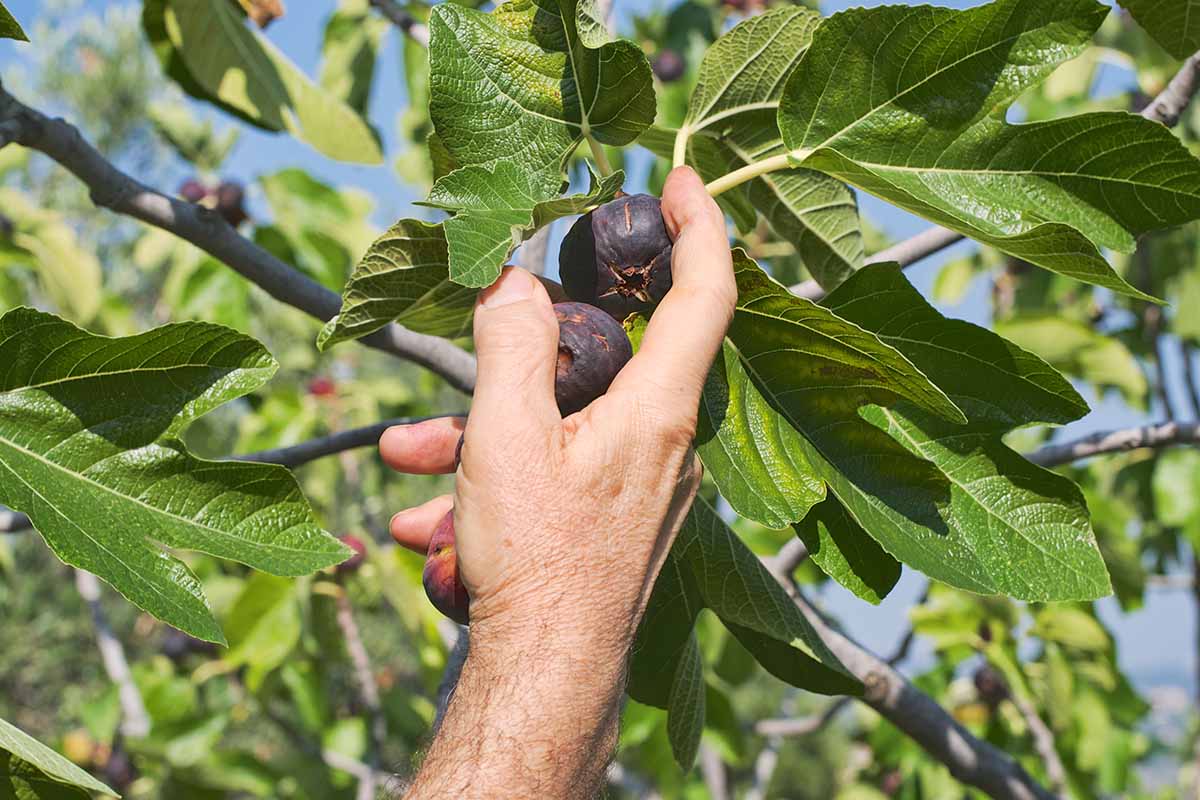
At this point, most people start to get antsy to pluck the fruits, but they aren’t ready yet, even though they don’t seem to be doing anything.
But after the 30 day period has passed, they will soften and change color, with the sugars fully developing and the caustic sap being eliminated from the fruit. This typically happens about two to three weeks after the 30 day period.
One way to tell if your figs are ready to harvest is when the neck becomes nice and soft and the fruit droops. If you harvest the fruit, no white sap will leak out of the neck.
Don’t press the base of the fruit and assume it’s good to go just because it’s soft. These fruits ripen from the bottom up. It might still be unripe at the neck though the base feels ready and you’ll be disappointed.
The ripe fruits will be soft to the touch and the skin may begin to split. If you’re growing a brown variety, the skin will darken to a brownish-purple color just before harvest time. But you can’t rely on color for green types.

You’ll want to grab them at just the right time. Picked too soon, they aren’t yummy – and they won’t ripen once removed from the plant.
Here’s the tricky part: You have to time the harvest of the fruit perfectly, so you get them when they’re just ripe, but before the $#&%@#! squirrels get them! Or the birds.
Some gardeners cover smaller trees with netting to dissuade wildlife, but this is impractical with large trees. You simply have to be diligent about watching for ripeness and then beating the crafty creatures to the goods.
If you just can’t stand the thought of losing all your figs to herbivores, you can wrap each fig in a mesh bag. Motion sensors will also help for a day or two before the animals become habituated.
Preserving Fig Fruit
Harvested figs have a fairly short shelf life; store them in the refrigerator for two or three days, tops.
To dry these fruits, wash them thoroughly and then dry them with a towel. Place them whole or halved on a wire rack. Place the wire rack on a baking sheet.

Put the baking sheet in a 140°F oven for eight to 24 hours, checking the fruit for moisture and turning it as needed.
You can also use a dehydrator, following the same instructions. Learn more about dehydrators from this article on our sister site, Foodal.
You’ll know they’re dry when the outsides become leathery and you don’t see any juice on the inside. They should still be slightly pliable.
Store the dried fruit in the refrigerator or freezer in airtight containers for 18 to 24 months.
Recipes and Cooking Ideas
If eating them like candy somehow gets tiresome, you can preserve the fruits or add them to any number of recipes.
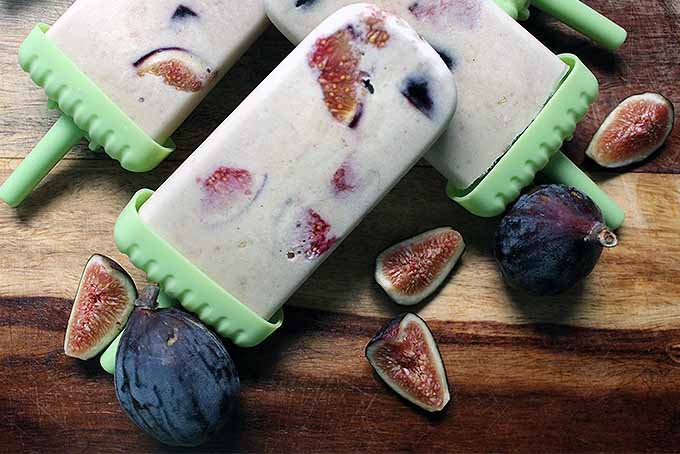
This recipe for tahini, honey-roasted fig, and banana popsicles from our sister site, Foodal is delicious. These frozen treats are filling and not too sweet.
Packed with figs, banana, and tahini, they do double-duty as breakfast or dessert.
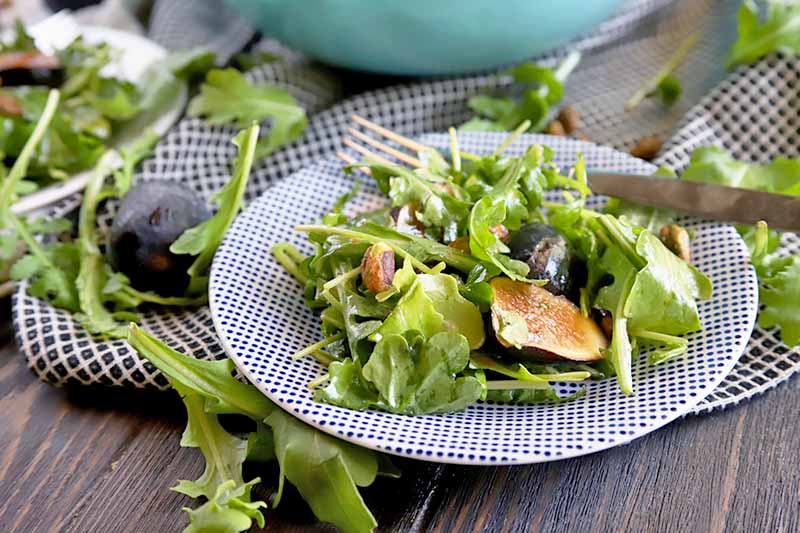
And a sweet fig livens up a fresh salad, too! Check out this recipe for arugula Dijon salad with figs, pistachios, and pea shoots, also from Foodal.
Or if you have an abundant harvest, check out this recipe for easy fig jam, also from Foodal.
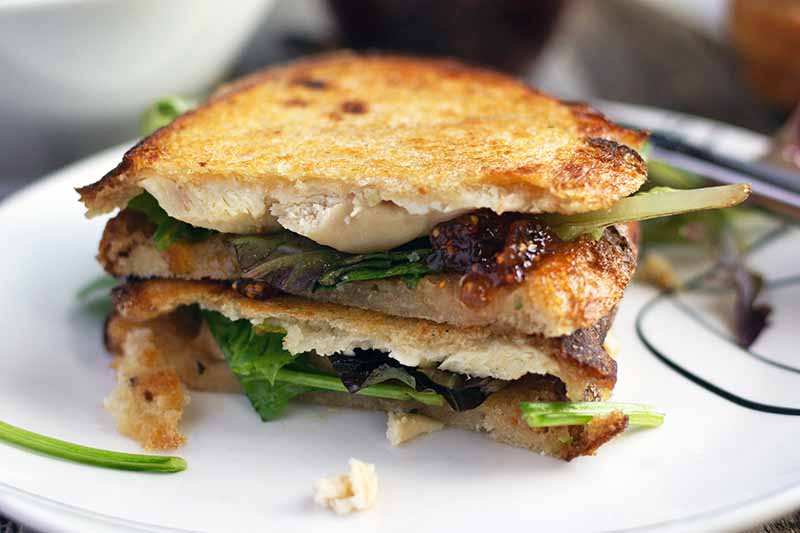
You can use your fresh, homemade jam in a hearty roasted chicken panini. Doesn’t that sound delicious? You can find the recipe over at Foodal.
Quick Reference Growing Guide
| Plant Type: | Deciduous fruit tree | Maintenance: | Low |
| Native to: | Middle East, northwestern Asia | Tolerance: | Drought |
| Hardiness (USDA Zones): | 6-10 | Soil Type: | Loamy |
| Bloom Time/Season: | Spring, summer, fall | Soil pH: | 6.0-7.5 |
| Exposure: | Full sun | Soil Drainage: | Well-draining |
| Time to Maturity: | Up to 6 years to produce fruit | Attracts: | Fig wasps |
| Spacing: | 10 feet, depending on cultivar | Companion Planting: | Cane berries, elderberries, garlic, marigolds, nasturtiums |
| Planting Depth: | 3 inches deeper than container (transplants) | Avoid Planting With: | Root vegetables (carrots, turnips, radishes) |
| Height: | Up to 70 feet | Order: | Rosales |
| Spread: | Up to 40 feet | Family: | Moraceae |
| Growth Rate: | Fast | Genus: | Ficus |
| Water Needs: | Moderate | Subgenus: | Ficus |
| Common Pests and Diseases: | Birds, squirrels; fig scale, root-knot nematodes; Botrytis blight, fig mosaic, rust | Species: | Carica |
Welcome the Fig Leaf
Clearly, we are wholly in favor of dismissing any negative connotations regarding the use of the fig leaf as a cover for things disagreeable.
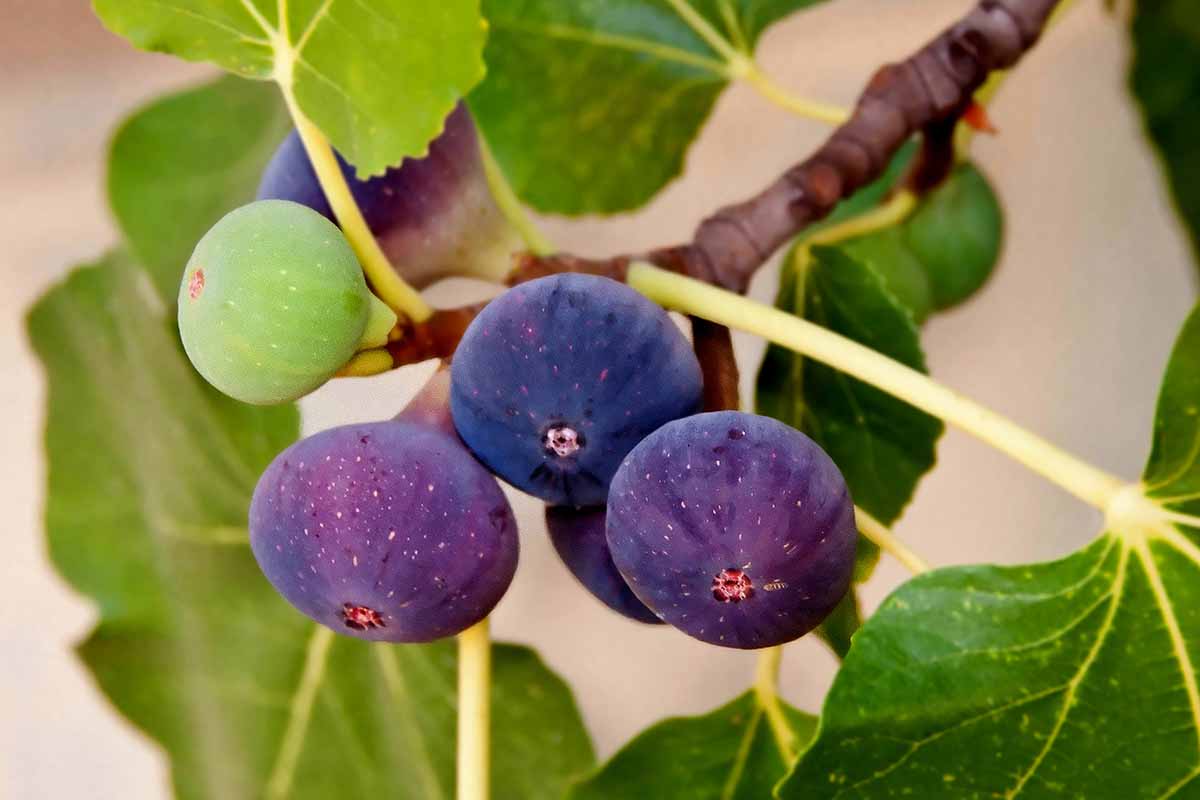
Indeed, the fig is a most agreeable and generous specimen of a plant whose fruit is more than 50 percent sugar. We dare you to cast aspersions on this benevolent beauty.
In fact, we ask: Why wouldn’t you plant this species? Southern gardeners, select a wide spot. Soon you’ll all be members of the fig fanatics club!
Do you have fantastic figs in your yard? Planning your late-night neighborhood escapade to “borrow” from the neighbors? Tell us more in the comments section below.
And if you’re looking to expand your homegrown fruit repertoire even more, check out these guides next:
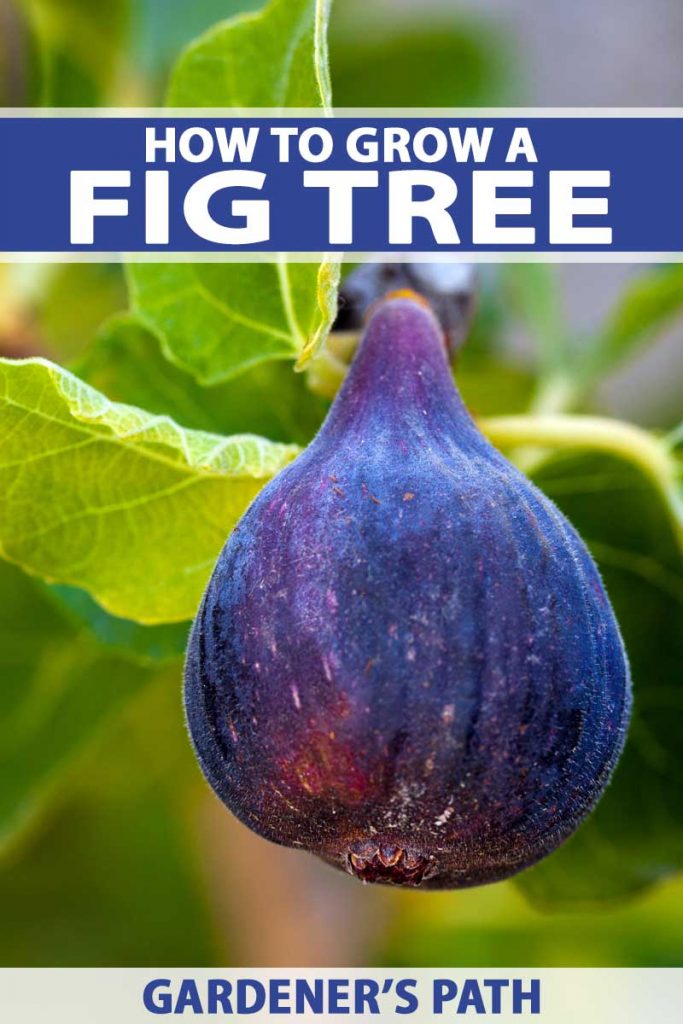

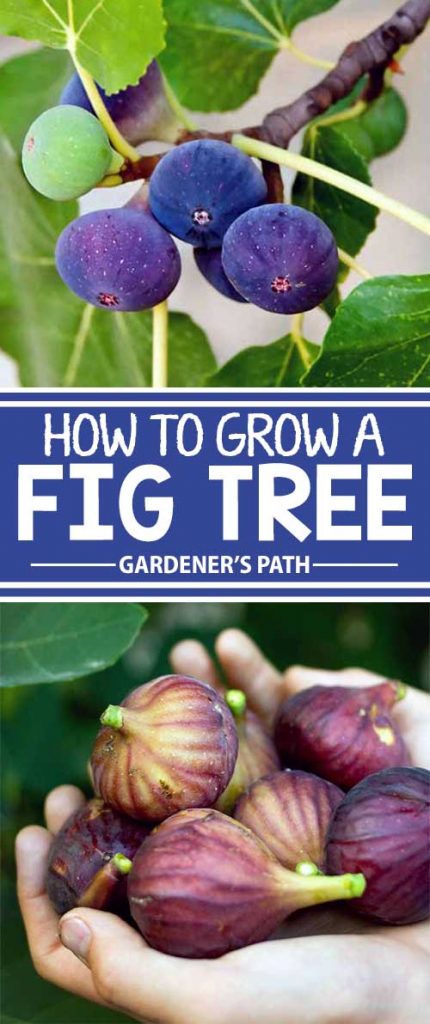
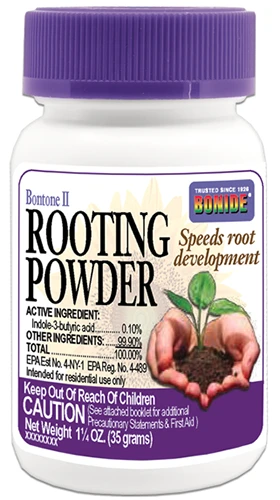
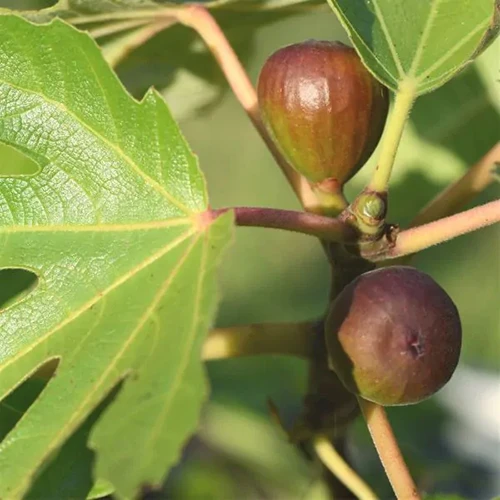
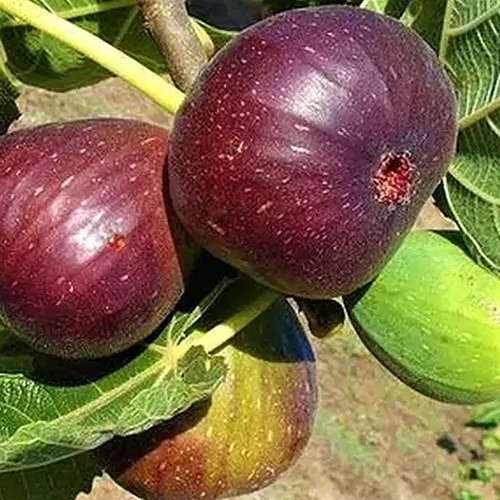
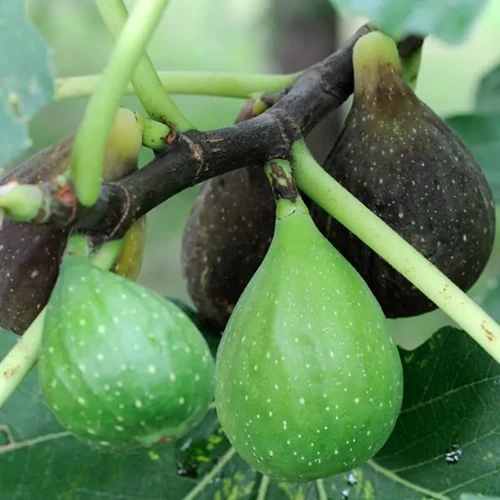

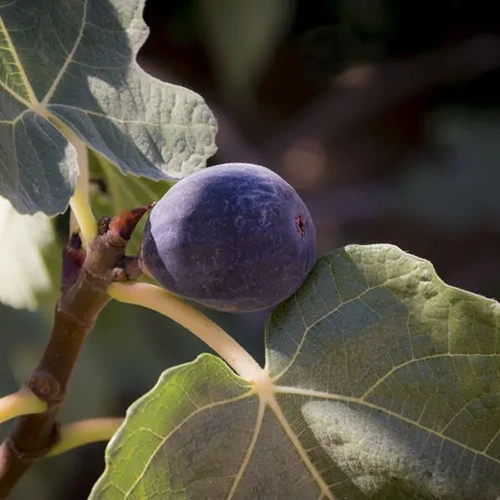
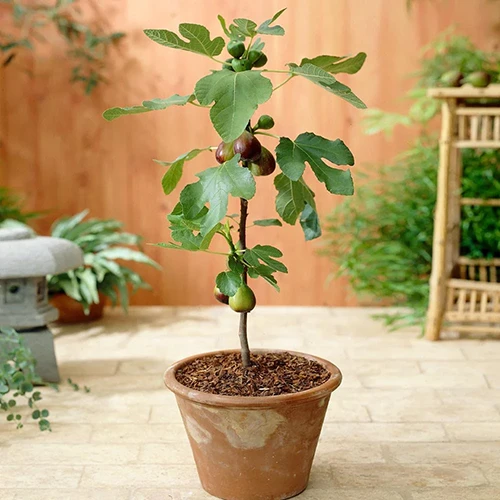
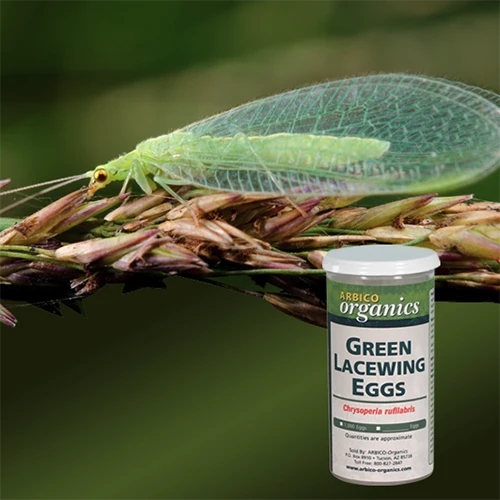
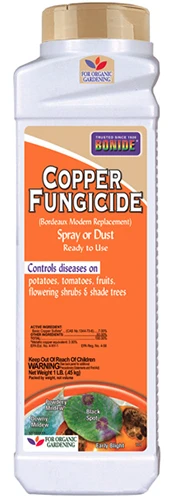
We live in Camino, CA, 1 hr east of Sacramento and 1 hr west of Tahoe. We have only been here a year and there is a fig tree in the yard that produces nothing. I would appreciate some advice about what we should do to get production from this beautiful little tree.
Yes. May still need a couple years to mature. Try pinching the tips of the branches when 4-6 leaves form to direct energy into the fruits. Continue this monthly.
Go fig-your type to grow.
Hi Robin, Thanks so much for reading and commenting. A few things might be preventing your fig from producing. The tree might not yet be mature enough to fruit. Most fig trees need to be at least two years old before they produce fruit, but some trees need to be as old as six years old. If a these trees receive too much nitrogen, that might prevent it from fruiting. You might want to switch to a fertilizer with less nitrogen or add phosphorus to balance the nitrogen. Finally, too much or too little water can affect a fig tree’s… Read more »
My fig tree is about 15 years old , started from a very old tree. It has been producing fruit for several years. However it always falls off before it can rippen? I’m in zone 9with watering restrictions. The mother tree was almost neglected and produced 3 harvests a year.
Any ideas ?
Thank you, Linda
Hi Linda…. thanks so much for reading my article! I’m sorry about your uncooperative tree — frustrating, isn’t it? I wonder if your watering restrictions are the cause. While figs can tolerate a dry spell, you might have better luck ensuring your tree gets about two inches of water per week while it’s fruiting. Also, put down a thick layer of mulch to retain the precious moisture you’ve given your tree. If your fruits are dropping when they’re very small, they may not have been pollinated. The tree won’t use resources to fully develop fruit that wasn’t pollinated. Hopefully you… Read more »
do you know if these can be grown indoors? I live in the Arizona desert and it reaches 115 F in the summer. I am afraid to place my 2 ft tree in the ground for fear it will die.
What variety do you have? Lots of gardeners have had success growing various types of fig trees in the Arizona desert, and a bonus there is that you won’t need to bring them indoors or go to any lengths to provide extra protection for the winter. ‘Kadota’ and ‘Conadria’ figs, for example, do very well in hot and dry conditions. Plants of all types actually tend to do better in the ground since pots typically dry out more quickly. Since they don’t require pollination to produce fruit it is technically possible to produce a harvest indoors, but potted figs tend… Read more »
My 3 fig trees are in pots on my screened in porch. They are covered with ants. How can I treat this? They are beginning to fruit.
Hi Sandy,
Thanks for reading my article!
The ants are probably snacking on aphids, which apparently taste pretty good.
Get rid of both ants and aphids with a strong stream of water, and then put down diatomaceous earth around your pots. Neem oil, too, is effective against these pests.
The fig tree needs the ants to pollinate the figs
Maybe be wise to pull the tree away from house
Actually, it’s usually wasps that pollinate figs! But certain types of predatory ants can actually help to protect these pollinators. You may find this study to be of interest.
My fig tree is already 4 years old, healthy and bears fruits every year in the summer. The problem is that the fruits don’t get ripe for harvest at all. I live in Vancouver, Canada. I know they can survive the weather here since I’ve seen them in other houses’ yards. Please help!
HI Loida,
Thanks for reading.
I’m wondering if your tree is stressed? This will cause it to halt the ripening process. Stress can be caused by lack of water or insufficient nutrition. As mentioned in the article, figs don’t usually require much fertilizing, but in your case, I’d probably ensure the tree has plenty of water, and if the fruit still doesn’t ripen, try applying a half pound of 10-10-10.
Also, be sure that your figs truly aren’t ripening, and it’s not just that the greedy wildlife is beating you to them!
Grow Desert King! 95% of fig cultivars don’t like Pacific NW weather. There is a nice one growing at the entrance to Stanley Park.
Check your plant to see if it has ants around it
Ants will help the fig tree ripen the fruit.
I had this problem when I had a bug man come out to exterminate the ants in my house. As soon as I fixed the ant problem my trees went dry. I replaced the ants for the trees and whalah! Sweet figs again. I have sugar ants in my trees. Just know they will invade the house if it’s to close.
I was given a potted fig tree that spread leaves and developed fruit. However, the fruit is dropping and many leaves have dropped. I figure it is probably stressed as we have had some pretty severe summer weather and inconsistent watering. What concerns me is there is a yellow mushroom that keeps popping up on the surface ground and out of a crack in the pot. I am afraid this fungus is going to kill the tree. I know this is not the time to transplant anything, but I wonder if it wouldn’t benefit my fig tree to put it… Read more »
Mary, thank you for reading my article.
Is your tree getting too much moisture? Is the pot in full sun? The fungus likely won’t hurt the tree but its presence indicates that the soil is too moist, so you might let the soil dry out completely between waterings and also put the container in full sun.
My fig drops some leaves after the fruits are gone, in late July and August when it’s hotter than the face of the sun here in Austin.
My fig tree dies back every winter and comes back in spring. Is there anything I can do to protect it? It is on the south side out by the barn but is out in the open.
I am in Zone 6B (Chicago) and planted a fig tree several years ago. I bought a fairly mature plant that was about 5 feet tall. I have gotten fruit every year. In the winter I wrap it up: burlap, then lots of leaves and hay or straw, then bubble wrap. Then I top it off with a plastic trash can lid which keeps most of the rain and snow out but allows ventilation. So far so good. Friends of mine who live on Cape Cod use a different method: they dig a trench beside their tree, partially uproot it… Read more »
Great tips, Patricia! Thanks for sharing!
That’s amazing. I also live in the Chicago area and I can’t imagine it surviving outside when the temps drop to -20. I wheel mine into the garage and cover them every winter. I bet you get more figs, having it in the ground versus a larger pot.
As far as the Adam and Eve part (may Allah be pleased with them both of them). Allah commanded them to use those leaves. So therefore they are not treated unjustly. Moreover, humans have a higher status than any other creatures on this earth. Allah created Everything.
Thanks for your comment, Sharenzaa. The writer is referring here to the derivation of the term “fig leaf” in its secondary definition, explained by Merriam-Webster’s dictionary as “something that conceals or camouflages usually inadequately or dishonestly.” When used in a more secular and modern context, there’s a negative connotation here, one that the plant perhaps does not deserve.
Thanks for reading!
It’s quite unlikely that Adam and Eve used fig leaves for privacy as the sap is very irritating to the skin and I doubt God would have commanded such a thing. They felt shame having their eyes opened to the knowledge of good and evil and probably grabbed whatever was closest at hand when they heard Jesus walking among them.
I have had a fig tree for 10 years or more. Lots of green edible figs. This year, loaded as usual. Green, hard as rocks, never ripened yet. I live in Punta Gorda, Florida.
Did your fruit ever ripen? Mine in Texas don’t usually ripen until July. If they didn’t ripen, they might be stressed from lack of water or nutrients.